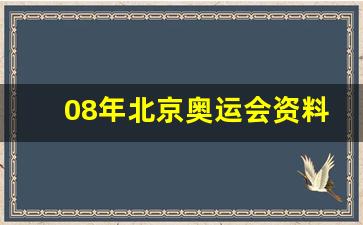1.关于2008北京奥运的简要资料
2.2008年北京奥运会的主题是什么?
3.关于08年北京奥运会的资料(要是英文滴....)
4.08年北京奥运会多少金牌
5.2008北京奥运会资料
关于2008北京奥运的简要资料

2008年8月8日 ,奥运会开幕式开始了
算上润年多一天 和从今年8月21号起 到08年8月8号那天
是352天!
2008年8月8日 ,奥运会开幕式开始。
所以还有365-13天也就是352天。
奥运来吧!!! 2008年北京奥运会吉祥物
吉祥物一词,源于法国普罗旺斯语Mascotto,意能带来吉祥、好运的人、动物或东西。
2008年奥运吉祥物是五个拟人化的福娃,英文译名为Fuwa.分别为:鱼、熊猫、藏羚羊、奥林匹克圣火和燕子形象,色彩与奥林匹克五环一一对应,具有极强的可视性和亲和力。五个吉祥物的名字是贝贝、晶晶、欢欢、迎迎、妮妮,即北京欢迎你。福娃代表了梦想以及中国人民的渴望。他们的原型和头饰蕴含着其与海洋、森林、火、大地和天空的联系,其形象设计应用了中国传统艺术的表现方式,展现了中国的灿烂文化。
北京奥组委对这组融儿童与动物为一体的五个娃娃形象组成的吉祥物进行了解读。“福娃”的色彩与灵感来源于奥林匹克五环、来源于中国辽阔的山川大地、江河湖海和人们喜爱的动物形象。向世界各地的孩子们传递友谊、和平、积极进取的精神,以及人与自然和谐相处的美好愿望。
“福娃”是五个可爱的亲密小伙伴,每个娃娃都有一个朗朗上口的名字:“贝贝”、“晶晶”、“欢欢”、“迎迎”和“妮妮”。在中国,叠音名字是对孩子表达喜爱的一种传统方式。当把五个娃娃的名字连在一起,你会读出北京对世界的盛情邀请“北京欢迎你”。“福娃”的原型和头饰蕴含着其与海洋、森林、火、大地和天空的联系,应用了中国传统艺术的表现方式,展现了灿烂的中华文化。北京奥运会吉祥物的每个娃娃都代表着一个美好的祝愿:繁荣、欢乐、激情、健康与好运。娃娃们带着北京的盛情,将祝福带往世界各个角落,邀请各国人民共聚北京,欢庆2008奥运盛典。
在设计思想上,北京奥运会吉祥物首次把动物和人的形象完美结合,强调了以人为本、人与动物、自然界和谐相处的天人合一的理念;在设计理念上,首次把奥运元素直接引用到吉祥物上,如火娃的创意来源于奥运会圣火;在设计应用上,更加突出了延展使用上的个性化。一大特点就是五个吉祥物的头饰部分,可以单独开发出来,运用更为广泛,孩子们可以根据自己的喜好选取不同的头饰,戴在头上,活泼的孩子也成了可爱的吉祥物形象,互动性大大增强;在数量上,北京奥运会的吉祥物也是奥运会历史上最多的一次,达到5个,体现了中华文化博大精深。
福娃贝贝*水*中华鲟—— 灵感来源:中国年画-莲年有余、中国传统鱼纹样、水浪纹样
福娃晶晶*木*熊猫—— 灵感来源:熊猫、宋代瓷器莲花造型
福娃欢欢*火*火娃哪吒—— 灵感来源:中国传统火纹图案、敦煌壁画中的火焰纹样
福娃迎迎*土*藏羚羊—— 灵感来源:中国青藏地区的装饰造型纹样、小藏羚羊
福娃妮妮*金*风筝或燕子—— 灵感来源:燕子、沙燕风筝
福娃贝贝
代表物:鱼
寓意:传递财富
福娃晶晶
代表物:大熊猫
寓意:奉上欢乐
福娃欢欢
代表物:奥林匹克圣火
寓意:带来激情
福娃迎迎
代表物:藏羚羊
寓意:展示绿色奥运
福娃妮妮
代表物:燕子
寓意:送上喜悦
2008年北京奥运会的主题是什么?
2008年的北京奥运会的主题是:绿色奥运、科技奥运、人文奥运。
“绿色奥运、科技奥运、人文奥运”表达了北京人民和中国人民与世界各国人民共有美好家园,同享文明成果,携手共创未来的崇高理想;表达了一个拥有五千年文明,正在大步走向现代化的伟大民族致力于和平发展,社会和谐,人民幸福的坚定信念;表达了13亿中国人民为建立一个和平而更美好的世界做出贡献的心声。
扩展资料
“绿色奥运”是2008年北京奥运会的三大主题之一,其内涵是:
要用保护环境、保护资源、保护生态平衡的可持续发展思想,指导运动会的工程建设、市场开发、采购、物流、住宿、餐饮及大型活动等,尽可能减少对环境和生态系统的负面影响;
要积极支持政府加强环境保护市政基础设施减河,改善城市的生态环境,促进经济、社会和环境的持续协调发展;
要充分利用奥林匹克运动的广泛影响,开展环境保护宣传教育,促进公众参与环境保护工作,提高全民的环境意识;
所谓科技奥运是指把现代科学技术多角度、多渠道地嵌入奥运会,通过广泛应用当代最先进的科技成果,让科学精神、思维和科技成就渗透到奥运会的每一个细节,使2008年北京奥运会成为被先进科技成果装备起来的体育盛会。
科技奥运是说:08年奥运会有含有高科技含量的建筑
人文奥运是说:中国有五千年的历史文化遗产
绿色奥运是说:中国将走环保路线在奥运期间和未来
百度百科-绿色奥运
百度百科-科技奥运
关于08年北京奥运会的资料(要是英文滴....)
The Official Mascots of the Beijing 2008 Olympic Games
Like the Five Olympic Rings from which they draw their color and inspiration, the Five Friendlies will serve as the Official Mascots of Beijing 2008 Olympic Games, carrying a message of friendship and peace--and blessings from China--to children all over the world.
Designed to express the playful qualities of five little children who form an intimate circle of friends, the Five Friendlies also embody the natural characteristics of four of China's most popular animals--the Fish, the Panda, the Tibetan Antelope, the Swallow--and the Olympic Flame.
In China's traditional culture and art, the fish and water designs are symbols of prosperity and harvest. And so Beibei carries the blessing of prosperity. A fish is also a symbol of surplus in Chinese culture, another measure of a good year and a good life. The ornamental lines of the water-wave designs are taken from well-known Chinese paintings of the past. Among the Five Friendlies, Beibei is known to be gentle and pure. Strong in water sports, she reflects the blue Olympic ring.
Each of the Friendlies has a rhyming two-syllable name--a traditional way of expressing affection for children in China. Beibei is the Fish, Jingjing is the Panda, Huanhuan is the Olympic Flame, Yingying is the Tibetan Antelope and Nini is the Swallow.
When you put their names together--Bei Jing Huan Ying Ni--they say "Welcome to Beijing," offering a warm invitation that reflects the mission of the Five Friendlies as young ambassadors for the Olympic Games.
The Five Friendlies also embody both the landscape and the dreams and aspirations of people from every part of the vast country of China. In their origins and their headpieces, you can see the five elements of nature--the sea, forest, fire, earth and sky--all stylistic rendered in ways that represent the deep traditional influences of Chinese folk art and ornamentation.
Spreading Traditional Chinese Blessings Wherever They Go
In the ancient culture of China, there is a grand tradition of spreading blessings through signs and symbols. Each of the Five Friendlies symbolizes a different blessing--and will honor this tradition by carrying their blessings to the children of the world. Prosperity, happiness, passion, health and good luck will be spread to every continent as the Five Friendlies carry their invitation to Beijing 2008 to every part of the globe.
At the heart of their mission--and through all of their work--the Five Friendlies will seek to unite the world in peace and friendship through the Olympic spirit. Dedicated to helping Beijing 2008 spread its theme of One World, One Dream to every continent, the Five Friendlies reflect the deep desire of the Chinese people to reach out to the world in friendship through the Games--and to invite every man, woman and child to take part in the great celebration of human solidarity that China will host in the light of the flame in 2008.
In China's traditional culture and art, the fish and water designs are symbols of prosperity and harvest. And so Beibei carries the blessing of prosperity. A fish is also a symbol of surplus in Chinese culture, another measure of a good year and a good life.
The ornamental lines of the water-wave designs are taken from well-known Chinese paintings of the past. Among the Five Friendlies, Beibei is known to be gentle and pure. Strong in water sports, she reflects the blue Olympic ring.
Jingjing makes children smile--and that's why he brings the blessing of happiness wherever he goes. You can see his joy in the charming naivety of his dancing pose and the lovely wave of his black and white fur. As a national treasure and a protected species, pandas are adored by people everywhere. The lotus designs in Jingjing's headdress, which are inspired by the porcelain paintings of the Song Dynasty (A.D.960-1234), symbolize the lush forest and the harmonious relationship between man and nature. Jingjing was chosen to represent our desire to protect nature's gifts--and to preserve the beauty of nature for all generations. Jingjing is charmingly na?ve and optimistic. He is an athlete noted for strength who represents the black Olympic ring.
奥运会基本简介 :(1)Baron de Cupertino designed the Olympic Flag in 1913-14. It has five interlocking rings (blue, yellow, black, green and red) on a white background. The ring's colours were based on the knowledge that at least one of these colours is on every flag of each participating country. The five interlocking rings represent the union of the five continents and the meeting of the athletes of the world at the Olympic Game.
The Olympic Flag was used for the first time in the 7th Olympiad in Antwerp, Belgium in 1920. It is paraded during the opening ceremony of each Game. At the end of the Games, the Olympic Flag is presented to the next host city by the Games host city.
(2)A flame was lit during the entire event of the Olympics during the ancient Olympic Game known as the Olympic Flame.
A new flame is lit using a parabolic mirror to focus the rays of the Sun at the ancient Olympic Stadium in Olympia, Ellis, Greece. The Flame is then transported to the host city where the last runner lights the large Olympic Cauldron by it and this burns throughout the Games. The Flame is extinguished during the closing ceremony. The Olympic Flame was first lit during the opening ceremony of the IX Olympic Games at Amsterdam, Netherlands in 1928.
The first Olympic Torch Relay occurred at the 1936 Berlin Olympic Games
08年北京奥运会多少金牌
302块金牌。2008年北京奥运会共有204个国家及地区派出代表团参加北京奥运会,参赛运动员达10942人,共设置28个大项、302小项的赛事,共产生302块金牌。008年北京奥运会,是第29届夏季奥林匹克运动会,开幕式于2008年8月8日举行,8月24日闭幕。
2008北京奥运会资料
一,奥运会的项目:
在2008年北京奥运会上,28个大项和分项比赛项目已经不会有变。现在距离2008年奥运会还有三年,比赛项目基本都确定了。那么,奥运会的项目又是如何划分的呢?
根据国际奥委会的资料,奥运会比赛项目是这样划分的:大项(SPORT)、分项(DISCIPINES)和小项(EVENT)。
与雅典奥运会一样,北京奥运会的比赛项目是大项28项,这28项为:田径、赛艇、羽毛球、垒球、篮球、足球、拳击、皮划艇、自行车、击剑、体操、举重、手球、曲棍球、柔道、摔跤、水上项目、现代五项、棒球、马术、跆拳道、网球、乒乓球、射击、射箭、铁人三项、帆船帆板和排球。
其中,有些项目没有分项,分项最多的是水上项目,包括了游泳、花样游泳、水球和跳水4个分项。田径虽然没有分项,却有46个小项,其中男子24个小项,女子22个小项,是奥运会项目中金牌最多的。其次是游泳,虽然没有分项,但是有32个小项,男女各16项。
国际奥委会主席罗格说,武术将作为比赛项目出现在2008年北京奥运会上,其全称是“北京2008奥运会武术比赛”。
罗格是在到南京参加中国第十届全国运动会开幕式期间作上述表示的。他说,尽管武术比赛有别于奥运会其他28个大项的比赛,但这毕竟是武术走向奥林匹克舞台的重大突破。
据国家体育总局武术运动管理中心主任王筱麟介绍,罗格是13日在南京接受媒体采访时谈到北京申请进入奥运会问题的。这也是罗格首次表示武术将成为2008年北京奥运会的比赛项目,同时也澄清了“武术将成为2008年北京奥运会表演项目”的传闻。
据悉,有关北京2008年奥运会武术比赛的细节问题,国际武术联合会和北京奥组委将与国际奥委会进行更加深入的磋
28个大项
302个小项
303块金牌
没有,根据《奥林匹克宪章》要作为奥运会比赛项目,必须在奥运会举行前7年决定,新进项目加入奥运会前作为表演项目出现。
二,奥运会吉祥物:
福娃是北京2008年第29届奥运会吉祥物,其色彩与灵感来源于奥林匹克五环、来源于中国辽阔的山川大地、
江河湖海和人们喜爱的动物形象。福娃向世界各地的孩子们传递友谊、和平、积极进取的精神和人与自然和谐相
处的美好愿望。
福娃是五个可爱的亲密小伙伴,他们的造型融入了鱼、大熊猫、奥林匹克圣火、藏羚羊以及燕子的形象。
福娃贝贝 福娃晶晶 福娃欢欢 福娃迎迎 福娃妮妮
每个娃娃都有一个琅琅上口的名字:“贝贝”、“晶晶”、“欢欢”、“迎迎”和“妮妮”,在中国,叠音名
字是对孩子表达喜爱的一种传统方式。当把五个娃娃的名字连在一起,你会读出北京对世界的盛情邀请“北京欢
迎您”。
福娃代表了梦想以及中国人民的渴望。他们的原型和头饰蕴含着其与海洋、森林、火、大地和天空的联系,
其形象设计应用了中国传统艺术的表现方式,展现了中国的灿烂文化。
将祝福带往世界各个角落
很久以来,中国就有通过符号传递祝福的传统。北京奥运会吉祥物的每个娃娃都代表着一个美好的祝愿:繁
荣、欢乐、激情、健康与好运。娃娃们带着北京的盛情,将祝福带往世界各个角落,邀请各国人民共聚北京,欢
庆2008奥运盛典。
贝贝传递的祝福是繁荣。在中国传统文化艺术中, “鱼” 和 “水” 的图案是繁荣与收获的象征,人们用
“鲤鱼跳龙门”寓意事业有成和梦想的实现,“鱼”还有吉庆有余、年年有余的蕴涵。
贝贝的头部纹饰使用了中国新石器时代的鱼纹图案。贝贝温柔纯洁,是水上运动的高手,和奥林匹克五环中
的蓝环相互辉映。
晶晶是一只憨态可掬的大熊猫,无论走到哪里都会带给人们欢乐。作为中国国宝,大熊猫深得世界人民的喜
爱。
晶晶来自广袤的森林,象征着人与自然的和谐共存。他的头部纹饰源自宋瓷上的莲花瓣造型。晶晶憨厚乐
观,充满力量,代表奥林匹克五环中黑色的一环。
欢欢是福娃中的大哥哥。他是一个火娃娃,象征奥林匹克圣火。欢欢是运动激情的化身,他将激情散播世
界,传递 更快、更高、更强的奥林匹克精神。欢欢所到之处,洋溢着北京2008对世界的热情。
欢欢的头部纹饰源自敦煌壁画中火焰的纹样。他性格外向奔放,熟稔各项球类运动,代表奥林匹克五环中红
色的一环。
迎迎是一只机敏灵活、驰骋如飞的藏羚羊,他来自中国辽阔的西部大地,将健康的美好祝福传向世界。迎迎
是青藏高原特有的保护动物藏羚羊,是绿色奥运的展现。
迎迎的头部纹饰融入了青藏高原和新疆等西部地区的装饰风格。他身手敏捷,是田径好手,代表奥林匹克五
环中**的一环。
妮妮来自天空,是一只展翅飞翔的燕子,其造型创意来自北京传统的沙燕风筝。“燕”还代表燕京(古代北京
的称谓)。妮妮把春天和喜悦带给人们,飞过之处播撒“祝您好运”的美好祝福。
天真无邪、欢快矫捷的妮妮将在体操比赛中闪亮登场,她代表奥林匹克五环中绿色的一环。





